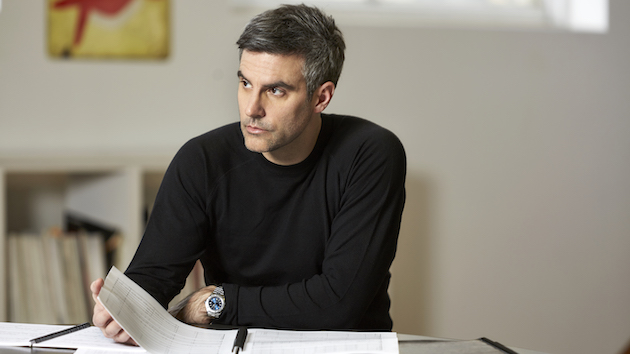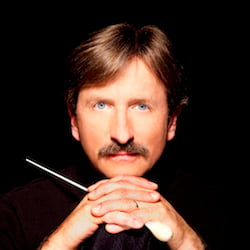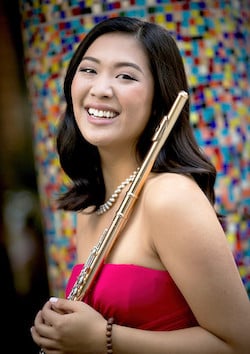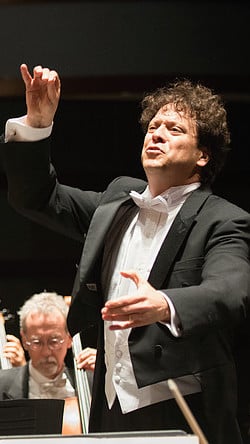
Sometimes, linear isn’t boring.
Case in point, plot the career trajectory of composer Kevin Puts from his early childhood, when he played pieces by classical music masters on piano by ear and recordings of music by Beethoven and Dvořák were favored by his parents, neither of whom are professional musicians. Flash forward to the endpoint, when the Pulitzer Prize- and Rome Prize-winning artist’s grand, cinematic symphonies, operas and other works fill concert halls with vast, panoramic presentations or raw, visceral, tightly constructed compositions.
The sequential journey includes interesting internal zigzags. As a teenager celebrating his birthday with a party, Puts would invite his friends to come into his bedroom to listen to his record collection. It wasn’t rock n’ roll, funk, disco, or early hip-hop. Instead, it was Beethoven’s Fifth Symphony, Dvořák’s “From the New World” and The Grand Canyon Suite for orchestra by Ferde Grofé. “You know, the warhorses,” Puts says in an interview. His serious tone is an indication that three decades later, at age 44, he either doesn’t register or dismisses the humorous image of 15-year-old kids grooving to Grofé,

Another peak moment spreads itself over three years, from 1996 to 1999, when Puts was the Walnut Creek-based California Symphony’s composer-in-residence. “It was (founder and then music director) Barry Jekowsky’s idea to have the program, and without his belief in me, I certainly wouldn’t be doing so much orchestral work today.” The Young American Composer-In-Residence program allows fledgling composers guided by the music director to create, rehearse, premiere, and record three major orchestra compositions during consecutive seasons.
Puts earned bachelor and Doctor of Musical Arts degrees from the Eastman School of Music. A faculty member at the Peabody Institute since 2006, he is the director of the Minnesota Orchestra Composer’s Institute. His debut opera, Silent Night, was based on the based on the 2005 film Joyeux Noel and won a 2012 Pulitzer Prize. His most recent work, The City, premiered in Baltimore and New York in April 2016 and was cocommissioned by the Baltimore Symphony Orchestra in honor of its 100th anniversary and by Carnegie Hall in honor of its 125th anniversary.
“I loved film scores to movies like Star Wars. They were rich and beautiful,” he recalls, referring to reviews that often mention the cinematic style of his larger works. “In general, music comes out of me very naturally. I work in a linear fashion with a score and don’t skip around.”

In his first year with California Symphony, Puts created Network, a fanfare-like blast of surging, suspense-filled melodic lines and relentless rhythms that will open the orchestra’s 30th anniversary season on Sept. 18. The program includes Mozart’s Flute Concerto in G-Major, with guest soloist and Pleasanton native Annie Wu, and Rachmaninoff”s Symphony No. 2. “It has something that is new and exhilarating (Puts), something by a beloved composer that isn’t typically heard (Mozart), and something that we all know and love and are excited to hear again (Rachmaninoff),” writes Music Director Donato Cabrera in an email about the program.
Cabrera became the symphony’s second-ever maestro in 2013. In August 2016, he concluded his longtime tenure as the resident conductor of the San Francisco Symphony and Wattis Foundation music director of the San Francisco Symphony Youth Orchestra. He is music director of the Las Vegas Philharmonic Orchestra.
Cabrera calls a performance of Network “a happy homecoming,” and says, “Puts has always had a wonderful sense of how to utilize the orchestra’s forces in an exciting and individual way and he has always had a lovely and unique sense of harmony and melody.”
Puts describes Network differently. “It’s not who I am today, but it’s still the music that I loved in school. It was during a time that I thought I had to figure out what a post-minimalist-with-near-romantic-tendencies composer sounded like.” Which isn’t to say he doesn’t recognize the piece’s virtues. After revisions Puts made in 2001, he says, “It sounds complete. I’ve always thought the proportions are good and the pacing works.”
Lessons emerged from the first-year experience — how to avoid wasting time rewriting during rehearsals that passed “like a blur,” the idiomatic features of instruments, protocol and etiquette in relating to the conductor, and more. Perhaps the biggest lesson was learning to trust his language, to allow more variety and theatricality by not getting stuck on a chord, and writing toward transcendence instead of academic structure. “The third piece was Symphony No. 1 and took a different approach to writing. It was more true to who I am as a musician: the kid improvising on the piano,” he says.

Cabrera hears in Puts’ music evidence of a composer who has “allowed his ideas about melody to really flow and take the lead.” Similarly, he’s been inspired while tracking Wu’s career trajectory as she has risen from high school musician and member of the San Francisco Symphony Youth Orchestra to national and international stages. “What sets her apart from other young and aspiring talents is her sure joy of music making. She has that rare ability to lift the spirit of an entire room of people, just by her sheer presence. This rare gift is only amplified by her unparalleled artistry and technique,” says Cabrera. The Mozart concerto he likens to “a perfect little engraving by Dürer,” and says Wu’s effervescent personality is a fine match to the work.
Puts says residencies for emerging composers like the programs in California and Minnesota are essential first-tier opportunities, but reading sessions, festivals, and ensemble residencies also provide multiple opportunities for more established composers to test and create new works.
And for sought-after composers like Puts, the biggest barriers to his development are collaborators who “tiptoe around, not saying if it isn’t working for them.”
Puts is currently focused on two new works: his first chamber opera, an adaptation of Peter Ackroyd’s gothic novel, The Trial of Elizabeth Cree, with libretto by frequent collaborator Mark Campbell; and a work for soprano Rénee Fleming and orchestra based on the personal letters of Georgia O’Keefe. Although O’Keefe’s paintings are well known, Puts says most people don’t know about the poetic, lovely letters she wrote. “When we approached her estate (to ask for the rights) to use them, no one knew what to do because no one had ever asked for the letters. At first, they said ‘OK, you can do it and perform it once.’ We said, ‘No, no, we need to do lots of performances, maybe record it.’” The estate agreed, and Puts and Fleming plan to expand the piece to include a baritone and letters that O’Keefe exchanged with her husband, photographer Alfred Stieglitz. Like a cartographer unafraid to venture “off the map” and in words that sound like a teenage echo, Puts says that the music he hears in his head today is much like the music played at those long-ago parties: “It’s big harmonies, percussion, tremolos, rich, colorful — and all that stuff.”
Correction: The first published version of this article suggested that Donato was still resident conductor with the San Francisco Symphony and music director of the S.F. Youth Orchestra. He concluded his tenure in those positions effective Aug. 2016.

